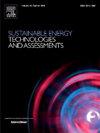Phase characteristic control strategy for the front powertrain of series mild HEV considering dynamic response of engine-generator set
IF 7.1
2区 工程技术
Q1 ENERGY & FUELS
Sustainable Energy Technologies and Assessments
Pub Date : 2025-01-01
DOI:10.1016/j.seta.2024.104138
引用次数: 0
Abstract
The front powertrain of series mild hybrid electric vehicles (HEVs) often struggles to meet the vehicle’s instantaneous power demand due to insufficient dynamic response of the engine-generator set (EGS) and battery power limitations, leading to poor dynamic characteristics and fuel economy. To address this issue, a phase characteristic control strategy for the front powertrain is proposed. It establishes a four-quadrant working plane for fuel-electric dual-source power output and divides it into twelve phase domains based on power flow, encompassing all possible operating modes of series mild HEVs. Considering the lag effect of the turbocharged engine, phase domain switching strategies are proposed for transient operating conditions, and the phase trajectory laws of the front powertrain are derived. Simulations conducted to validate the strategies show that, compared to the baseline, the proposed strategies reduce acceleration time by 8.9 % and 42.6 % during acceleration from 0 to 32 km/h, and decrease equivalent fuel consumption by 5.4 % and 7.0 %, respectively. Under braking condition from 40 to 20 km/h, the phase domain switching strategy improves braking energy recovery by 41 % compared to the baseline, with the EGS exhibiting improved dynamic response after braking.
求助全文
约1分钟内获得全文
求助全文
来源期刊

Sustainable Energy Technologies and Assessments
Energy-Renewable Energy, Sustainability and the Environment
CiteScore
12.70
自引率
12.50%
发文量
1091
期刊介绍:
Encouraging a transition to a sustainable energy future is imperative for our world. Technologies that enable this shift in various sectors like transportation, heating, and power systems are of utmost importance. Sustainable Energy Technologies and Assessments welcomes papers focusing on a range of aspects and levels of technological advancements in energy generation and utilization. The aim is to reduce the negative environmental impact associated with energy production and consumption, spanning from laboratory experiments to real-world applications in the commercial sector.
 求助内容:
求助内容: 应助结果提醒方式:
应助结果提醒方式:


